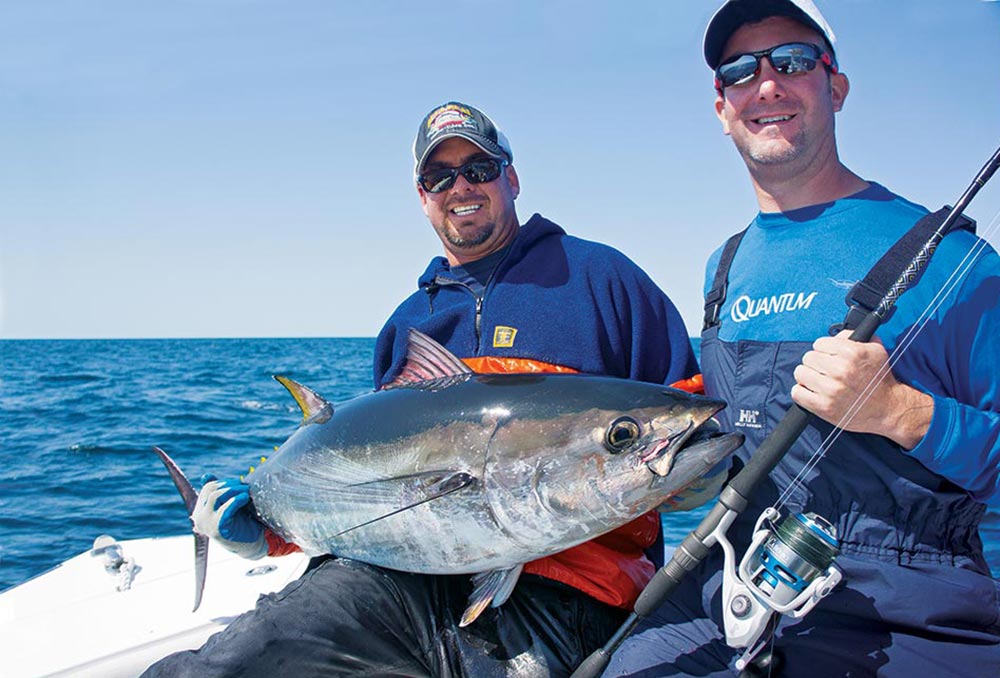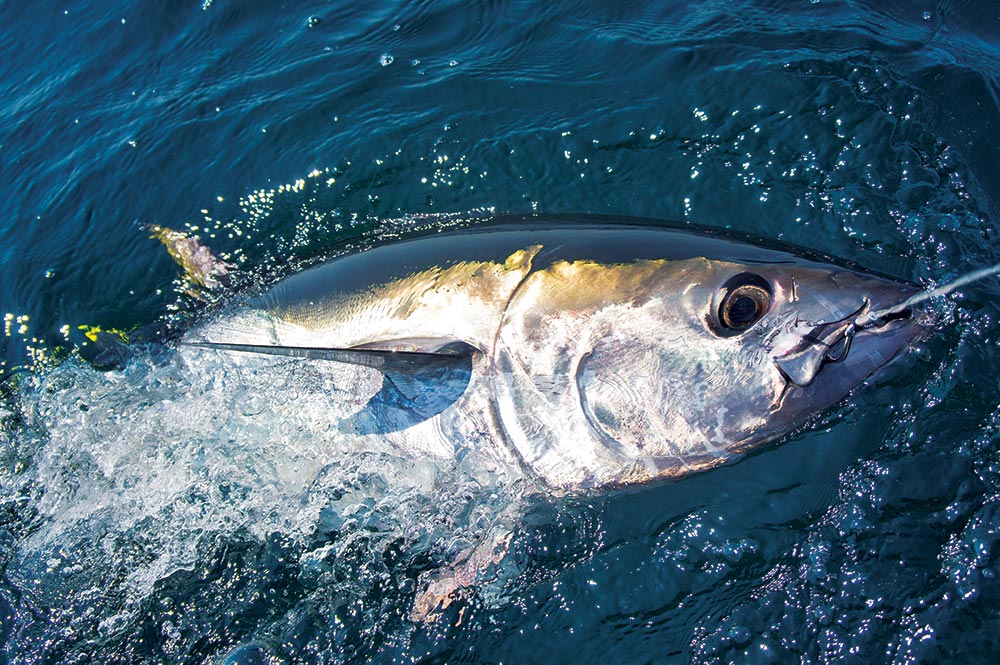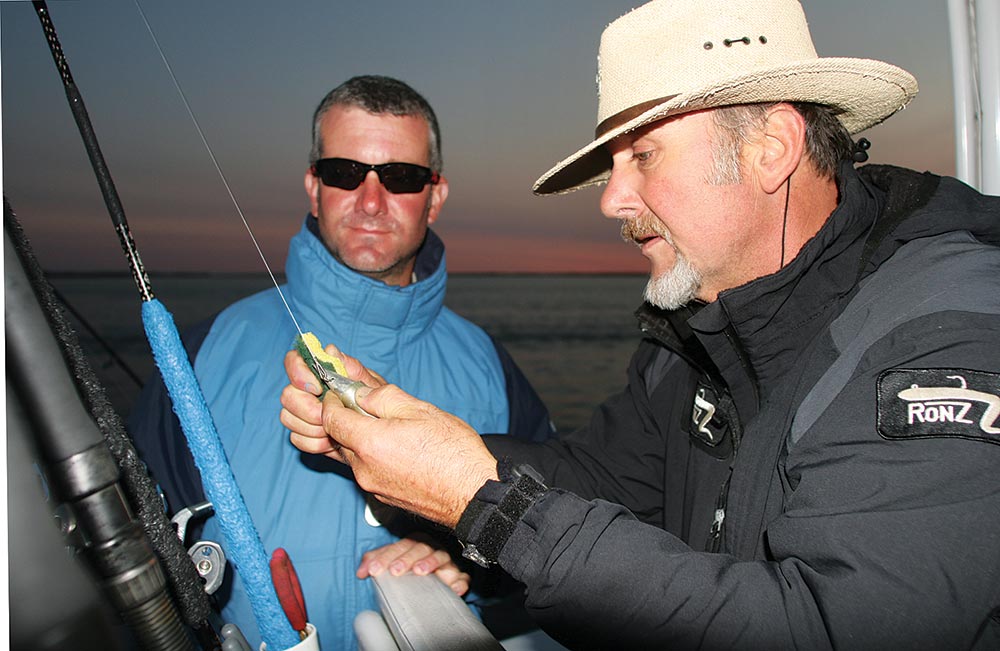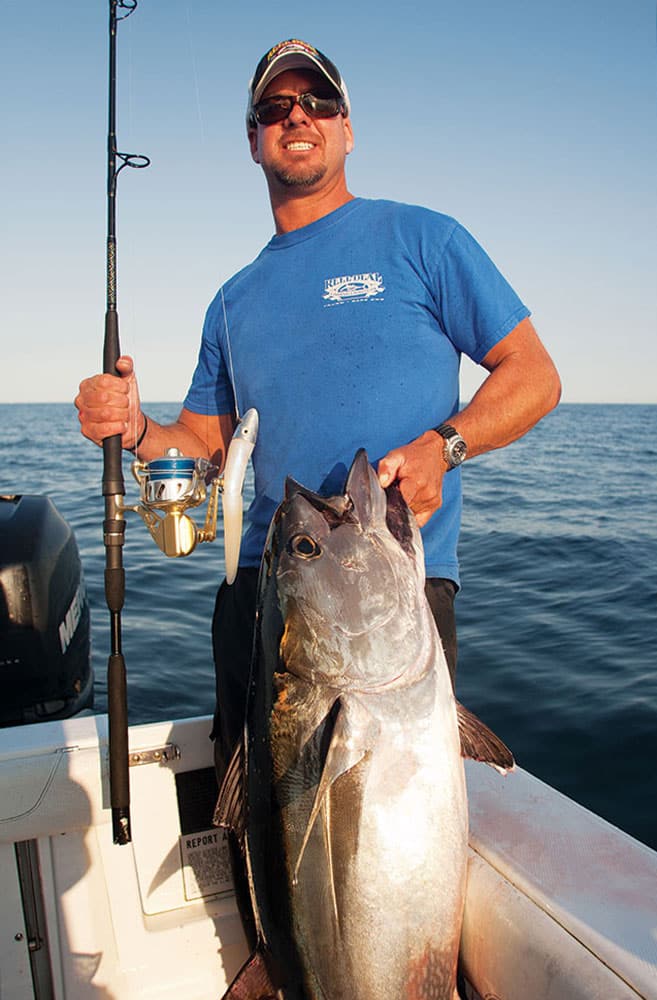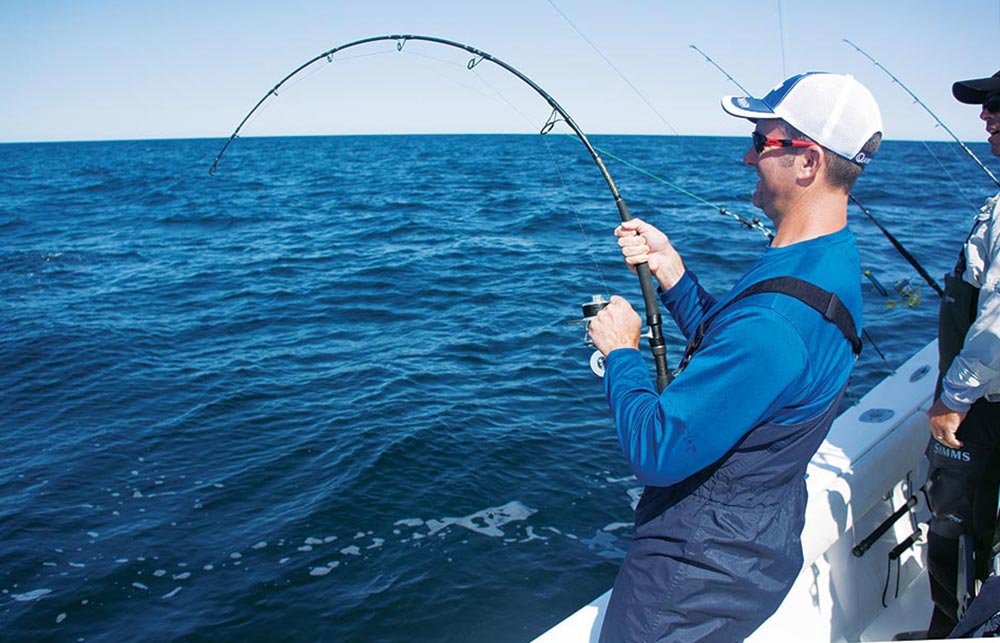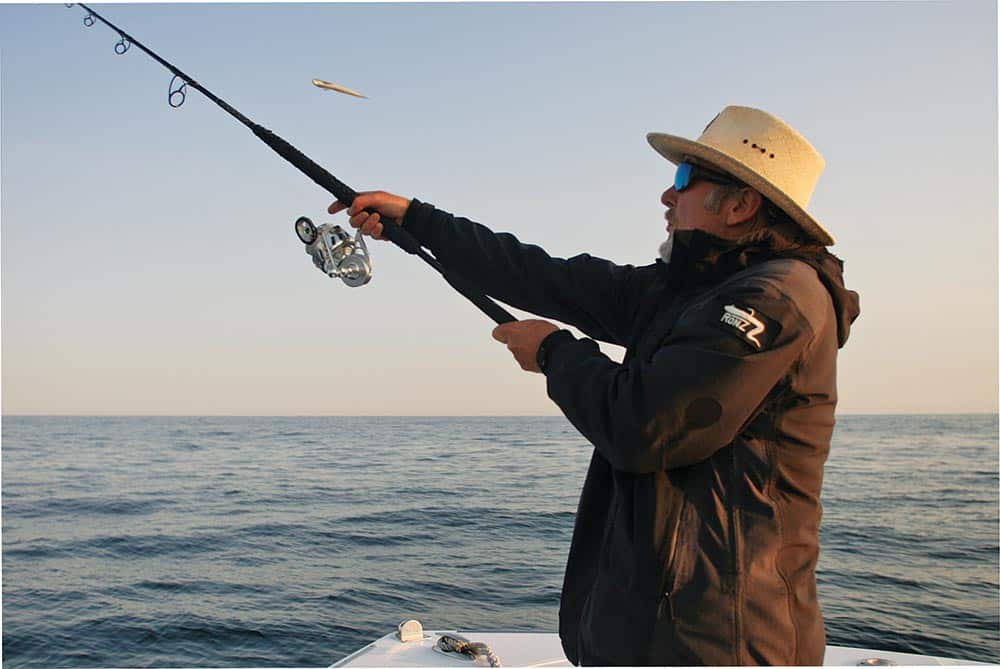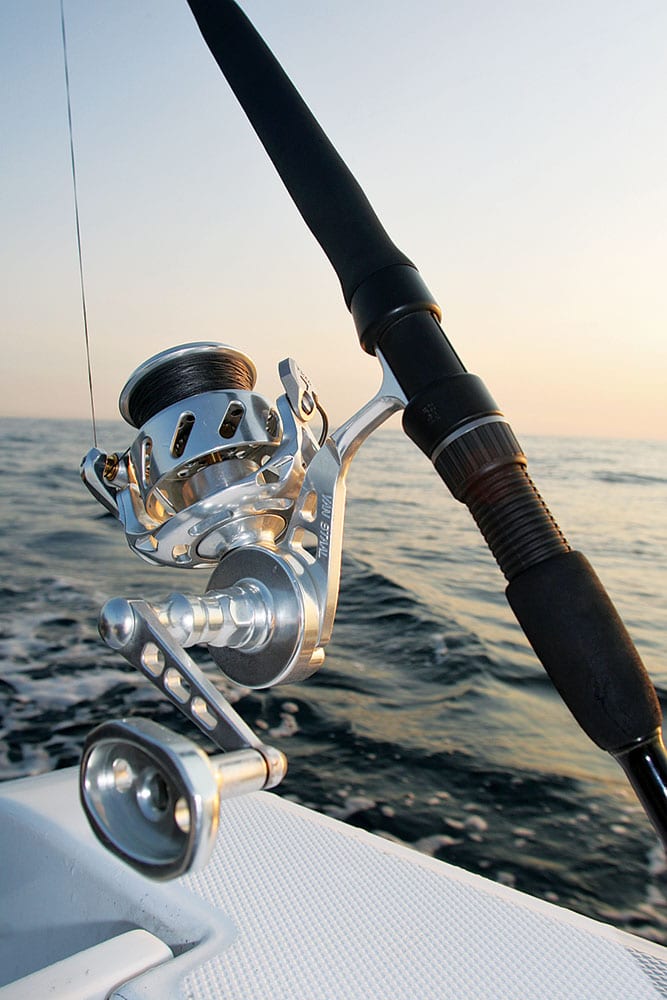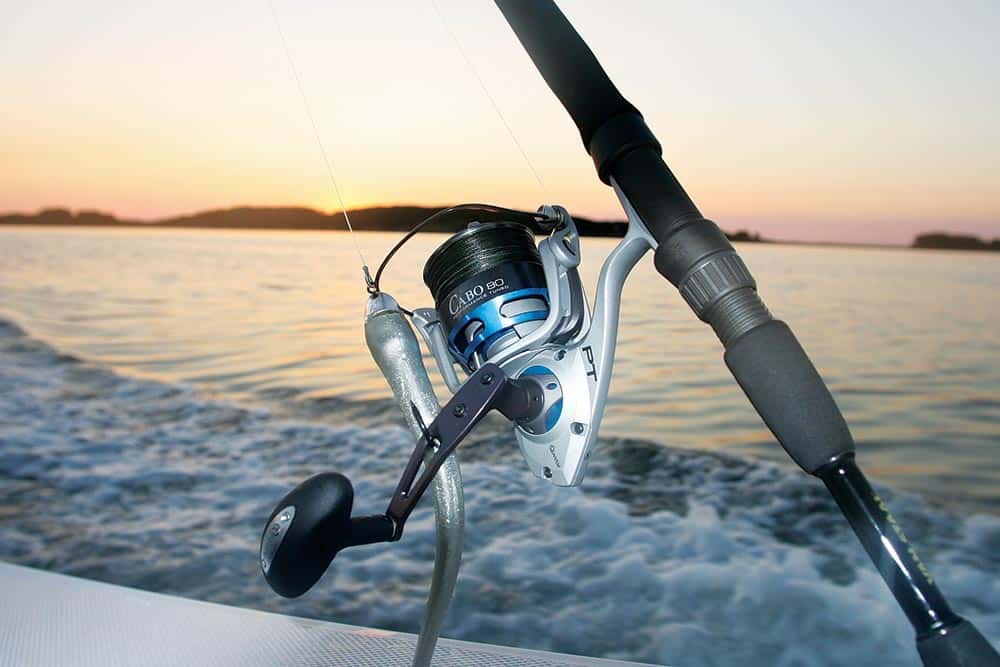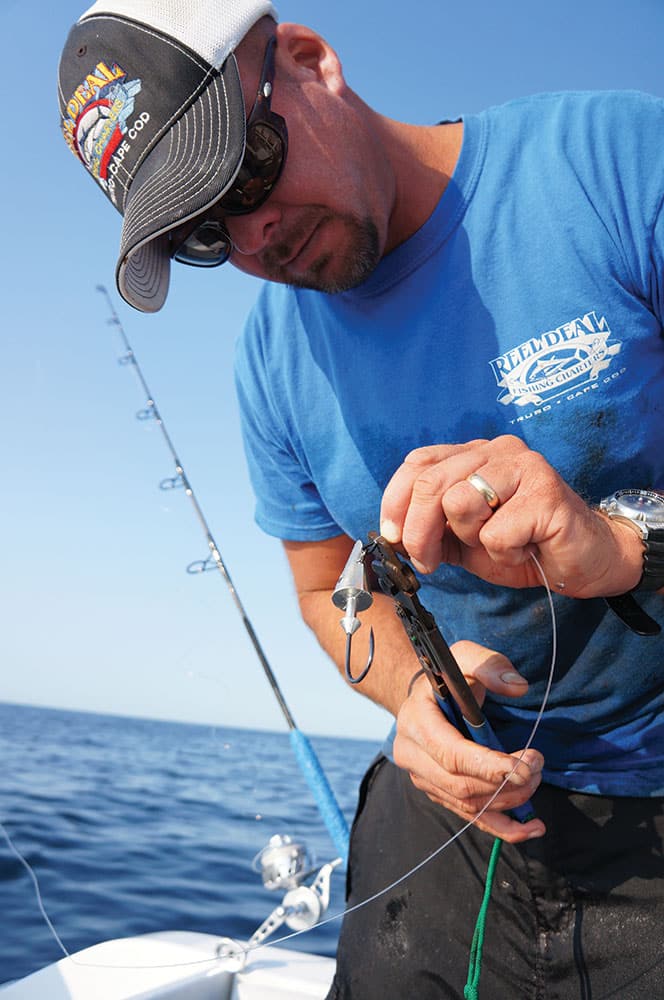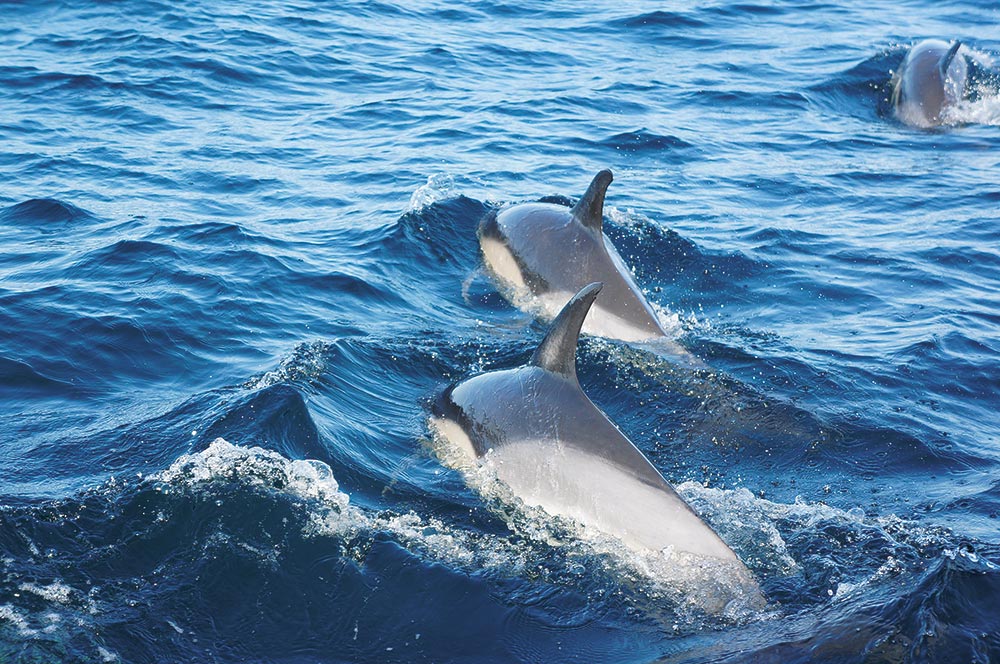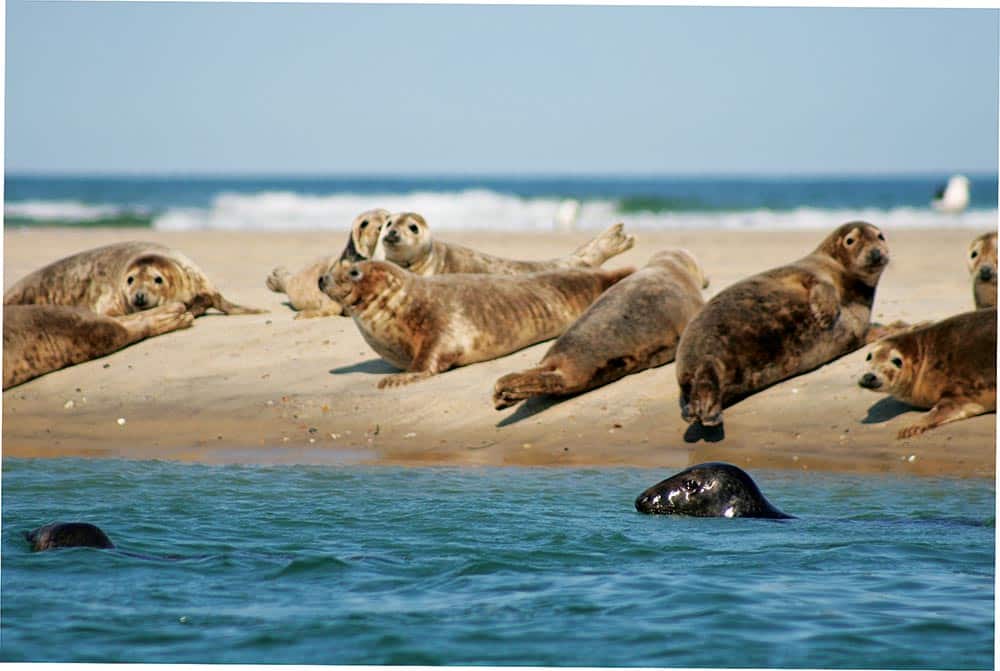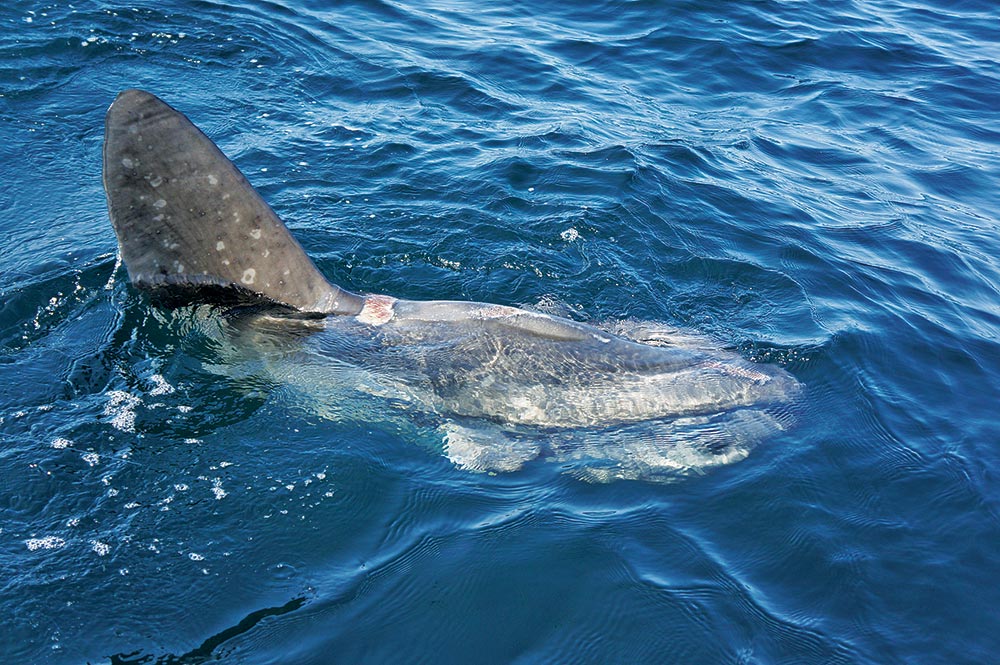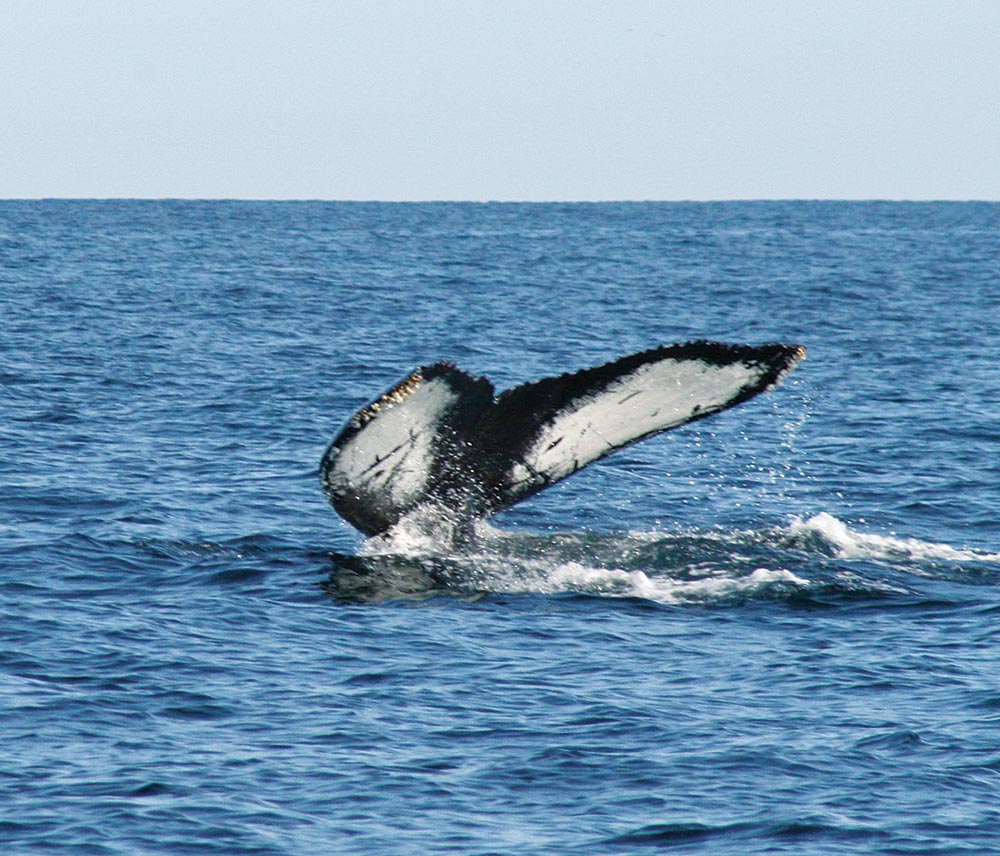That first, pretty September day hunting bluefins off Cape Cod, Massachusetts, started slowly, as we jigged the shipping lanes near Chatham Cut. But things were about to change. Peering through his binoculars toward the horizon, Capt. Bobby Rice had just seen something he liked. “Whales,” he muttered, quickly instructing us to bring in our lines and hang on as he throttled down toward the breaches. Soon we were dropping the 10-inch soft plastics again, now within plain sight of two massive humpbacks that rolled on the surface, blowing big mists.
I looked over at one of my fishing companions, Ron Poirier, a beloved local lure manufacturer. Poirier was locked in. He engaged his spinner at about 150 feet and began working his trademark RonZ fish-oil-infused soft plastic in a tap-tap-tap jigging action. Suddenly, Poirier’s Van Staal rod doubled over in a deep U-bend and he hollered.
Twenty minutes later, Poirier beamed like a child as the fat, 80-pound bluefin came aboard. He and Rice pulled the jig out of the fish’s mouth and — boom — just like that, we had our dinner for the evening.
A Bittersweet Personal Journey
I was 8 years old the last time I visited Cape Cod; this fall 2012 trip marked my first-ever tuna experience here. Unfortunately, it was one of Poirier’s last. The 58-year-old had been suffering Stage 4 esophageal cancer, though you never would have known from his sunny disposition and infectious laughter.
On May 3, 2013, just before this year’s tuna season, Poirier passed away, leaving behind a legacy as one of the most popular tuna fishermen on the Cape, and a person I was proud to have fished with on this trip.
Says Rice: “He was one of my best friends. We took a lot of tuna trips together. He was incredibly knowledgeable.”
Organized with pals Craig Cantelmo of Van Staal and Chris Littau, director of marketing at Zebco, the trip had been two years in the making. We had initially hoped to find a topwater bite that week off the Cape, but that wasn’t happening.
There were plenty of tuna around, and they were up near the surface. But they never showed themselves. Worse, as we approached likely bluefin pods in Rice’s 26-foot SeaCraft, the fish would scatter rather than dive deep, where we could have seen them on the fish finder. This made the jig bite a tough sell too.
All in all, we were met with difficult conditions, yet our confidence remained sky-high. “Bobby is the man,” Cantelmo told me repeatedly leading into the trip. “He finds fish, period.”
As usual, Cantelmo turned out to be on-point.
The Cape’s Rich Fishery
Cape Cod is as gorgeous as it is productive. Whales are quite common, and we delighted in watching the hundreds of porpoises that swam alongside Rice’s boat, and marveled at the occasional mola mola and curious blue sharks.
The bluefin here generally show up at the end of May and into the first two weeks of June. Many weigh well over 200 pounds, and the fishing can be incredible at times, with hordes of giants often mixing in close confines with striped bass in shallow, 40- to 70-foot depths. The giants move through fairly quickly, however, giving way to mostly school-size tuna in the 50- to 100-pound range that ride eddies from the Gulf Stream from mid-July through fall.
In late September, the giants pass through again. Fishing often remains good all the way until November.
“The primary area we fish is Stellwagen Bank,” says Rice. “It’s an excellent and very famous area. The sanctuary, the habitat and the high peak on the bank all make this place an amazing spot for tuna. A ton of bait always holds over it.” Part of a national marine sanctuary, the bank starts just 3 miles north of Cape Cod in Massachusetts Bay and depths range from 65 to more than 600 feet.
But Stellwagen isn’t the only spot for Cape Cod bluefin. We found quite a few tuna hanging in those 200-foot-deep channels off Chatham during our trip. And just 2 miles off the tip of the Cape, near Provincetown, is Peaked Hill Bar, another great spot. To the south lie the Crab Ledge, an expansive area off Orleans and Chatham, and the Regal Sword, a wreck some 30 miles east-southeast of Chatham and east of the Monomoy National Wildlife Refuge.
“There’s cooler water down in Chatham, a lot cooler than in Stellwagen,” says Rice. “It might be 65 to 70 degrees off Stellwagen, while in Chatham, it’s still in the mid-50s.” Rice prefers temps in the mid-50s to low 60s, noting that once the water temperature reaches the upper 60s to 70s, the fish disband.
The bluefins’ primary forage — herring and mackerel — are initially attracted to such temperature ranges. “Wherever the herring are, that’s where the tuna will be,” Rice says. “They find this bait and stay with them. Even if you can’t always see the bluefin, they’re probably around.”
Find Tuna at Depth
During the past couple of seasons, Cape Cod fishermen have experienced a lack of “visuals,” as Rice calls birds, whales, surface bait or crashing fish. That was decidedly not the case this past June, however, just seven months after our trip, when dozens of huge tunas were caught on the surface while crashing bait amid whales, birds and even striped bass.
“It was amazing,” Rice reports. “But every year is different; it’s constantly changing.”
One thing that doesn’t change when it comes to jigging, though, is that fish finders always play a key role. “It’s our primary tool,” says Rice, “the most important piece of the puzzle when jigging.”
Depending on the area he’s fishing, Rice most often jigs tuna in the 200- to 300-foot range, with the fish typically hanging 50 to 130 feet down.
“We look for marks on the machine,” he says. “You might see singles here and there or big groups of them, like 15 or 20. Sometimes, it can be upwards of 100. There might not be any surface activity at all, but the sonar becomes our primary tool to know where to jig.”
During our trip, we marked fish occasionally. They showed up as long, reddish-orange blips on Rice’s monitor. Any time we noticed this, we sent jigs down immediately. Doing so resulted in the bulk of our strikes.
Rice prefers a 10-inch RonZ with a 4x swivel-eye/swing-hook jig head. The lure comes with a Gamakatsu live-bait hook and an internal all-stainless-steel swivel that eliminates line twist and acts as a pivoting point for side-to-side jig action, which produces a seductive wiggle.
“The lead heads sink faster, but the shine on the tin model works much better,” says Rice, who prefers a silver tail but says that the black color can work particularly well during the spring, when the herring are thick.
The Right Tackle and Bait
These jigs — whether soft baits like RonZ products or all-metal jigs — are crimped to 60- to 90-pound mono leaders. Rice uses 10-foot leaders if casting the lures, and up to 22-foot leaders if simply dropping down and vertical jigging.
The leader is spliced to 80- to 100-pound braided main line, which we had spooled onto Quantum’s new Cabo 80 PTs reels and Van Staal VSB250S and VS275S reels, mounted on beefy Van Staal jigging rods, for this trip.
Yes, these spinning outfits might be considered light tackle at first blush; in fact, they are light in terms of weight. But they pack as much of a punch as any conventional outfit. The Cabo 80s, weighing only 25 ounces, generate an amazing 55 pounds of drag pressure. They proved more than adequate on the 60- to 100-pound bluefins we encountered. I was amazed at the efficient pressure I was able to apply to a respectable fish on our last day — my first bluefin ever on any type of gear.
On the way back in, winding through the towering sandy banks of the Chatham Cut, it was hard not to feel overwhelmed by the beauty of this place. And when Poirier slapped me on the back with a good, hearty chuckle, it became crystal clear why he loved this fishery so much — and why it’ll no doubt miss him.
Tuna on Topwater
When conditions are right, it’s possible to tangle with triple-digit bluefin tuna on topwater off Cape Cod. Here are a few pointers to keep in mind to maximize your success:
When he sees big schools of busting tunas, Capt. Bobby Rice likes to get ahead of the fish, positioning his boat upwind of the school. “You kill the motors and let them come right to you,” says Rice. “With the wind at your back, you can cast big lures 200 feet. As soon as the lure hits the surface, start working it. It usually doesn’t take long when they’re feeding.”
What lures does he use? “Shimano Orcas and the Tuna Candy by Gibbs Lures,” Rice says. “It’s a big pencil popper with a single Owner hook, oversize split rings, and a big swivel. The hook hangs off the back of the lure, and the hardware allows the lure to pivot against itself and not pull the hook on a big fish.”
Cape Cod Information
From Orlando, Florida, I flew into Providence, Rhode Island, rented a car and made the two-hour drive out to North Truro on the Cape. The drive gave me a great opportunity to soak in Cape Cod and its gorgeous grassy sand dunes, scrub pines, and juniper.
There are many nice places to stay here, but I checked in at Top Mast Resort. Very comfortable and convenient, Top Mast features an indoor pool, which feels particularly great after a couple of days slugging it out with bluefin tuna.
Cape Cod is also known for its fabulous seafood. Be sure to check out some of the joints in Provincetown, but you also must visit the Whitman House Restaurant and Bass Tavern at least once during your trip here. Owned by Capt. Bobby Rice’s parents, Bob and Sue, Whitman was, without a doubt, my favorite restaurant. The seafood is excellent and reasonably priced.
Remember that fishing for bluefins in federal waters requires vessel owners to possess a federal recreational permit. Anglers who stay in state waters must have a federal permit for the vessel if they plan to keep a tuna. Check hmspermits.noaa.gov for permit information and current tuna regulations.
Unless fishing from a permitted charter vessel, adult anglers fishing in Massachusetts need a $10 saltwater-fishing permit; visit mass.gov/eea/agencies/dfg.
Contacts
Capt. Bobby Rice
Truro, Massachusetts
508-487-3767
fishreeldeal.com
Top Mast Resort
North Truro, Massachusetts
800-917-0024
topmastresort.com
The Whitman House
Restaurant and Bass Tavern
Truro, Massachusetts
508-487-1740
whitmanhouse.com
